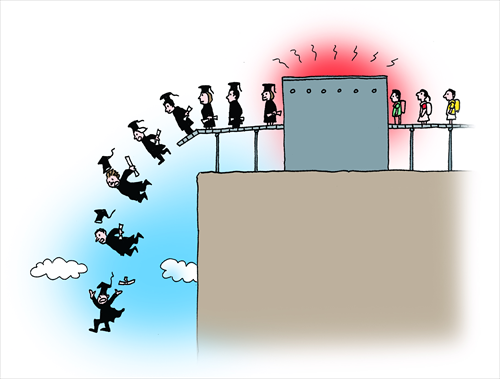HOME >> OP-ED
Education fails glut of graduates seeking jobs
By Rakesh Gupta Source:Global Times Published: 2015-6-15 20:33:01

Illustration: Liu Rui/GT
The university entrance exams for 2015 are over and approximately 9.5 million students can take a much needed break before the start of another round of stress when they will get their results and know which college they can go. For those who succeed in entering the college of their choice, it will be a dream come true. For the majority who fail to win entry into prestigious institutions, this is time for disappointment, compromise and accepting alternative institutions and courses that they can study over the next four years.
From a social standpoint, not going to university is not an option. Is this love affair with a university degree of benefit to individuals who spend a number of years in cramped dormitories spending hour after hour memorizing difficult scientific theories, learning a foreign language or understanding abstract philosophical concepts? Or is it to the benefit of society, which spends billions to subsidize the higher education system in China?
These questions need to be looked at very seriously by policymakers since the initial objective of raising adult literacy in China has been achieved. At the start of reforms in 1978, only 1.4 percent of the college age population reached higher education.
This year, over 9.5 million high school graduates took the gaokao, the dreaded university entrance exams. However, the meteoric rise in number of university graduates over time from less than 1 million in 2001 to over 7 million this year has caused its own problems.
Despite unemployment of 4.1 percent nationally, unemployment among recent university graduates is 15 percent after six months of graduation and is believed to be over 30 percent when including unemployed graduates from the preceding years.
This is not including underemployed graduates. It is not uncommon for wait staff or taxi drivers to have master's degrees. The employment crisis threatens to become a major social problem.
One of the causes of the growing unemployment in graduate population in China is the mismatch in the skill needs and the growing supply of generic graduates. This may be further accentuated by the hukou system that restricts the free movement of labor.
China needs to focus more on the education of young people and improve the proportion of students completing high school.
The focus should be on middle school graduates to complete either high school or go into vocational training programs that make them much better equipped for future jobs. This will also take some pressure off the tertiary education sector as young adults will have more options in terms of their future career choices.
This well-developed infrastructure has the potential to be used in the development of an education-export market. China over time is becoming an attractive destination for Asian students and existing higher education infrastructures can be further developed to make it more attractive for the international student market.
There are some shortcomings in the system that need to be addressed such as reliance on memorizing rather than understanding and overcrowded residential facilities. These should be seen as opportunities rather than problems because any investment in this sector will boost jobs and develop the education export market.
But there are other challenges. A large proportion of young people with schooling up to only grade nine may have been an advantage when China's economy was reliant on low value manufacturing and cheap labor. However, in the future when China aims to move to high value exports, there will be a need for skilled labor.
To achieve this, the average education and skill level of the labor force in the bottom group need to be higher and that can only be achieved by training or retraining this group.
China can learn from India where a parallel well-developed vocational training sector exists and has immensely contributed to India's economic growth.
One of the ways middle school leavers can be helped to attain a higher level of skill is by developing an effective vocational education sector. A vocational educational sector can provide specialized skills that equip young people for the job market.
Students also learn English at too late an age and are poorly motivated. The English curriculum relies mainly on rote learning of language but not deeper understanding of the language for any practical use. Reform here can greatly increase the potential competitiveness of students in an English-dependent global market.
Finally, China cannot afford the luxury of producing graduates in liberal arts from an economic standpoint; neither can it afford young people dropping out after middle school.
This love affair with university education for everyone needs to end. It is creating large number of unemployed and underemployed graduates who are deeply unsatisfied and provides a recipe for social disharmony at a huge cost to the national education budget.
To move forward, China needs the average skill levels of its young generation higher and more targeted university education for producing highly skilled labor.
English teaching also needs to be more targeted and aimed at people who choose to pursue it.
The author is a professor at the Department of Accounting, Finance and Economics, Griffith University, Australia, and a visiting fellow of Chongyang Institute for Financial Studies, Renmin University of China. opinion@globaltimes.com.cn
Posted in: Viewpoint